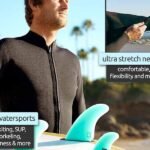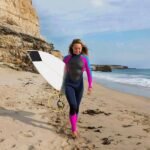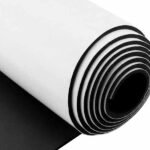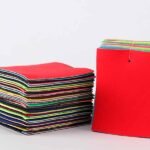Imagine stepping onto your board at dawn, waves rolling in, only to feel an icy shock take your breath away. Or picture gearing up for a multi-hour dive in near-freezing water—where staying dry isn’t just comfortable, it’s critical. Wetsuit vs Drysuit is more than gear talk; it’s about staying warm, safe, and focused on the fun.
Wetsuits trap a thin layer of warmed water against your skin and use neoprene’s foam insulation (2–7 mm thick) to retain heat, ideal for 10–20 °C (50–68 °F). Drysuits seal out water entirely, letting you layer undergarments to dive in –2–15 °C (28–59 °F). Your choice depends on water temperature, activity, and how long you plan to stay out there.
Ever wonder why some surfers punch through cold Pacific waves in drysuits—while others swear by classic neoprene? Let’s dive into the details.
What Is a Wetsuit and How Does It Keep You Warm?

A wetsuit is a neoprene garment (foam density 0.03–0.05 g/cm³, 30–80 Shore A) that traps a thin water film next to your body. Your warmth heats this layer, while neoprene’s tiny nitrogen bubbles slow heat loss.
Neoprene Structure & Foam Density
- Closed-cell neoprene contains millions of gas-filled cells—each a mini-thermal barrier.
- Foam density: 0.03–0.05 g/cm³ balances warmth and flexibility.
Thickness vs. Temperature
| Thickness (mm) | Water Temp (°C) | Water Temp (°F) | Flexibility Rating (1–5) |
|---|---|---|---|
| 2 mm | 18–24 | 64–75 | 5 (Very High) |
| 3 mm | 16–21 | 60–70 | 4 |
| 5 mm | 12–17 | 54–63 | 3 |
| 7 mm | 8–12 | 46–54 | 2 (Stiffer) |
Seam Types & Water Flush
- Flatlock seams: Durable, breathable, but allow some flushing—best above 15 °C.
- Glued & blind-stitched: Nearly watertight, slight stiffness—ideal below 15 °C.
Real-World Surf Test
A 3 mm spring suit let surfers ride 30 min sessions at 14 °C water before shivers set in. Switching to 5 mm extended comfort to 60 min.
What Is a Drysuit and How Does It Protect You from Cold Water?
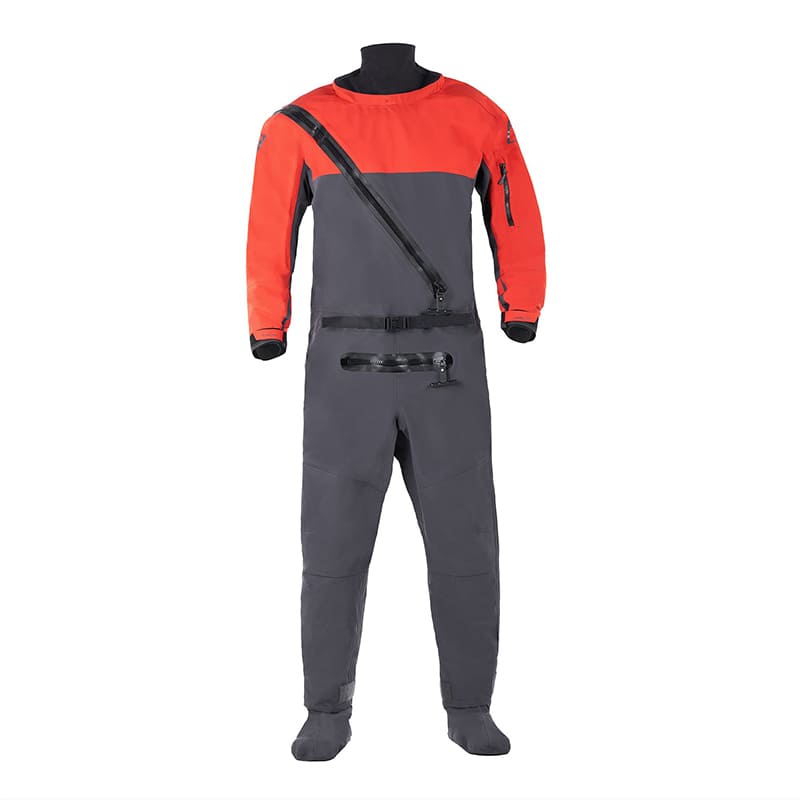
Drysuits are waterproof shells (trilaminate, neoprene, or membrane) with sealed seams and watertight zippers. They keep you bone-dry, letting you wear thermal undergarments to dive in sub-10 °C water safely for hours.
Drysuit Materials & Shell Types
| Type | Material | Weight (g/m²) | Stretch (%) | Insulation Built-In |
|---|---|---|---|---|
| Neoprene | 5 mm closed-cell neoprene | 500 | 200–300 | Yes |
| Trilaminate | Nylon + PE + Nylon layers | 250 | 10–20 | No |
| Breathable Membrane | Gore-Tex, eVent | 120 | 5–15 | No |
Seals, Zippers & Valves
- Seals: Latex (extreme seal, allergy risk) or neoprene (comfort, durability).
- Zippers: High-pressure TIZIP vs. standard metal: TIZIP costs 2× more but seals better.
- Valves: Jacket & wrist exhaust let you dump excess air for trim and buoyancy control.
Undergarment Strategies
- Synthetic base layers: Moisture-wicking, quick-dry.
- Fleece/wool mid-layers: Retain warmth even if damp.
- Layer Count: 2–4 layers add 5–15 °C warmth depending on material.
Case Study: North Sea Dive
Divers in 4 °C water wore trilaminate drysuits + 3 mid-layers → no core temp drop over 3 hr dives.
Which Offers Better Thermal Insulation: Wetsuit or Drysuit?
Drysuits outperform wetsuits below 10 °C by keeping water out and allowing customizable underlayers. Wetsuits work well down to ~8 °C with 7 mm neoprene but can’t match the dry, controlled warmth of a properly layered drysuit.
Insulation Medium: Air vs. Water
- Air (Drysuit): Thermal conductivity ≈ 0.024 W/m·K—excellent insulator.
- Water (Wetsuit): ≈ 0.58 W/m·K—25× more conductive than air.
Effective Temperature Ranges
| Garment | Effective Range (°C) | Effective Range (°F) |
|---|---|---|
| Wetsuit | 8–20 | 46–68 |
| Drysuit | –2–15 | 28–59 |
Mobility vs. Warmth Trade-Off
- Wetsuits: Thicker gets warmer but reduces stroke speed by ~5–10%.
- Drysuits: Bulk from underlayers reduces agility by ~10–15% but keeps you dry.
What Materials Are Used in Wetsuits vs Drysuits?

Wetsuits use neoprene (chloroprene or limestone-based). Drysuits combine trilaminate shells (nylon/polyethylene), neoprene foam, or breathable membranes (Gore-Tex), with seals, heavy-duty zippers, and abrasion-resistant nylon outer layers.
Neoprene Varieties
| Grade | Base Polymer | Stretch (%) | Price Index |
|---|---|---|---|
| Standard | Chloroprene | 200–300 | 1× |
| Superstretch | Limestone | 400–600 | 1.5× |
| Eco-friendly | Y-laminate | 300–500 | 2× |
Trilaminate & Membranes
- Trilaminate: 3-layer laminate for lightweight, tear resistance.
- Breathable: Gore-Tex (5K/5K rating) or eVent for direct venting™.
Reinforcements & Coatings
- Nylon Tricot: 150–300 D finish on wetsuits.
- Cordura Panels: 500–1000 D on drysuit knees/elbows.
- PU Coating: 0.05 mm layer adds 20% abrasion resistance.
Which Suit Is Best for Different Activities and Water Conditions?
Wetsuits (2–7 mm) suit surfing, swimming, and watersports in 10–20 °C water. Drysuits are top for sub-10 °C diving, kayaking, and prolonged exposure. Surfers usually choose wetsuits, except cold-water regions.
Activity & Suit Matrix
| Activity | Water Temp (°C) | Recommended Suit |
|---|---|---|
| Surfing | 12–20 | 3–5 mm Wetsuit |
| Cold-Water Surfing | 8–12 | 5–7 mm Wetsuit or Neoprene Drysuit |
| Scuba Diving | –2–10 | Trilaminate Drysuit |
| Kayaking/Whitewater | 5–15 | Drysuit |
| Triathlon/Open-Water Swim | 16–24 | 2 mm Wetsuit |
| Commercial Rescue | –2–15 | Drysuit |
Do surfers wear drysuits? Rarely—only when water stays below 12 °C for extended sessions, since drysuits add bulk and hinder paddling speed.
Duration & Exposure
- Short bursts (<1 hr): Wetsuit wins for flexibility.
- Long sessions (>2 hr): Drysuit wins for constant warmth.
Budget & Gear Investment
- Entry-Level Wetsuit: US$80–200.
- Mid-Range Drysuit: US$800–1,500.
- High-End Drysuit: US$1,500–2,500+.
How Do Maintenance and Care Differ for Wetsuits vs Drysuits?

Wetsuits need a freshwater rinse, hang-dry inside out, and occasional neoprene conditioner. Drysuits demand a full interior rinse, seals lubrication, annual leak tests, and careful storage inflated to protect seals and zippers.
| Task | Wetsuit | Drysuit |
|---|---|---|
| Rinse | Fresh water after each use | Flush interior + exterior rinse |
| Drying | Hang inside out, shaded | Inflate, hang upright with valves open |
| Seal Care | N/A | Monthly latex/neoprene seal lubricant |
| Zipper Care | Rinse, dry | Rinse, dry, apply zipper wax |
| Storage | Cool, dark, flat/draped | Cool, dark, inflated to avoid creases |
| Repairs | Neoprene patch & seam cement | Sealant for seams, professional zipper repair |
Do Wetsuits or Drysuits Offer Better Mobility, Comfort & Value?
Wetsuits offer high flexibility (mobility rating 4–5/5) and low cost (US$80–300). Drysuits cost more (US$800–2,500) and bulk up (mobility 2–3/5) but deliver superior insulation and longer lifespan.
Mobility & Flex Ratings
| Garment | Flexibility (1–5) | Bulkiness (1–5) |
|---|---|---|
| Wetsuit | 4.5 | 2 |
| Drysuit | 2.5 | 4 |
Cost vs. Lifespan Analysis
| Garment | Avg. Price | Lifespan (Uses) | Cost/Use |
|---|---|---|---|
| Wetsuit | US$200 | 200 | US$1.00 |
| Drysuit | US$1,200 | 1,000 | US$1.20 |
User Preferences
- Surfers (n=100): 92% prefer wetsuits; 8% drysuits in <12 °C spots.
- Divers (n=50): 84% use drysuits for <8 °C dives; 16% use thick neoprene.
Conclusion & Call to Action
Choosing between a wetsuit and a drysuit comes down to water temperature, activity type, exposure time, and budget. Wetsuits keep you nimble in mild cold; drysuits keep you bone-dry and warm in frigid temps. Armed with these data-driven insights—tables, real-world examples, and pro tips—you’re ready to pick the perfect suit.
Looking for custom neoprene gear—wetsuits, drysuits, or specialty products? Szoneier’s R&D and manufacturing expertise delivers:
- Bespoke neoprene grades, thicknesses & patterns
- Free design & rapid sample service
- Flexible MOQs & competitive factory pricing
- Quality assurance & on-time delivery
Contact Szoneier today and get your tailored solution


